一 : 潮州开元寺:潮州开元寺-简介,潮州开元寺-地理位置
位于广东省潮州市湘桥区开元路。占地约2万平方米,建筑面积约2580平方米,南向,是一座宫殿式的四合院建筑群。始建于唐开元二十六年(738年),历代多有修葺。现存建筑保留了唐代布局及宋、元、明、清历代建筑风格。主要建筑有金刚殿(山门)、天王殿、大雄宝殿、藏经楼、观音阁、地藏阁等。其中金刚殿面阔七间,进深四间,单檐歇山顶,为明代建筑。
潮州开元寺_潮州开元寺 -简单介绍
(www.61k.com]开元寺位於广东省潮州市区中心。前身为荔峰寺,唐代开元二十六年(738年)敕建开元寺,元代改为“开元万寿禅寺”,明代称:“开元镇国禅寺”,又叫”镇国开元禅寺”,加额“万寿宫”,俗称开元寺一直沿用至今。向为历朝祝福君主、宣讲官府律令之所。以地方宽敞、殿阁壮观、圣像庄严、文物众多、香火鼎盛而名闻遐迩,为粤东地区第一古刹,有“百万人家福地,三千世界丛林”之美誉。
开元寺是一座坐南朝北,四合院宫殿式的古建筑,整座寺院既保留了唐代的平面布局,又凝结了宋、元、明、清各个不同朝代的建筑艺术。现有占地面积20000平方米。主要建筑有:金刚殿(既山门)、天王殿、大雄宝殿、藏经楼、观音阁、地藏阁、香积橱、方丈厅、知客堂、神农堂、梵天香界照壁以及石经幢、阿育工式塔等。
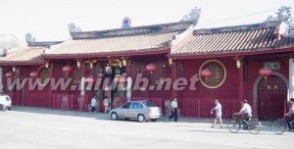
寺中还有智诚法师抗日战争期间闭关三年刺舌血书写的《大方广佛华严经》一部,八十馀万字,字字端楷,一丝不苟。时人赞曰:“三年般若心参透,一部华严血写成。”
寺内墙壁各处,镶嵌着众多官府文告和历代开元寺重修碑记石刻。1961年被确定为广东省重点文物保护单位,1983年被国务院确定为全国重点开放大寺。
潮州开元镇国禅寺向为十方丛林,住持由僧众推举;清代乾隆元年(1735年)礼请密因和尚任住持之後,改以曹洞法裔相承为住持。民国二十二年(1933年)恢复十方选贤制,近数十年来,住持分别由临济、曹洞、黄檗法裔出任。1950年纯信和尚被公推为住持,他曾发心代众生受苦而焚去二指。在极左路线重压下,为了保全开元寺,他上书中国佛教协会反映情况,使肉菜市场从寺中迁出,又带领僧众种田、辨酱油厂和柴炭门市部以自养;整修殿宇、重塑天王像,在任十六年,诸多建树,在文化大革命期间被逐返乡而逝。
改革开放後,住持慧原法师发大菩提心,多方奔走筹划经营,在海内外善信资助下,六载重修,使梵宇重光。1991年定然法师住持开元寺,订规立约,整肃道风。泰国华侨领袖、大慈善家谢慧如先生资肋七百馀万元在风光绮丽的韩江大桥东侧山麓兴建泰国式佛殿一座,每年均有数以十万计的侨胞、国内外高僧大德至此观光。1992年,定然法师在原来僧伽培训班基础上,恢复岭东佛学院(1933年太虚法师创办,1935年因经济困难停辨),礼聘德才兼备的法师任教,现已毕业三届学僧。1996年耗资五百馀万元,在开元寺西侧兴建占地二千馀平方米的园林式教学楼,其格调与开元寺主体古建筑相协调。
潮州开元寺_潮州开元寺 -地理位置
开元寺座落在潮州市区开元路中段。位于广东省潮州市韩江大桥东侧笔架山南麓。却位居闹市。潮州开元寺_潮州开元寺 -建筑风格
始建时占地百亩,历代沧桑,隆替不常;迄今尚存不足四十亩。经宋元明清及今,先後十次大规模修建,其建筑格局大致分为三部:中轴为照墙、山门、天王殿、大潮州开元寺_潮州开元寺 -历史沿革
寺内墙壁各处,镶嵌着众多官府文告和历代开元寺重修碑记石刻。1961年被确定为广东省重点文物保护单位,1983年被国务院确定为全国重点开放大寺。潮州开元寺_潮州开元寺 -其它相关
潮州开元寺大悲殿二 : 潮州开元寺
潮州开元寺——岭南名胜中英文导游(12)
转载
岭南名胜
中英文导游
旅游 ▼ (2011-01-22 13:46:28) 分类:新聊斋/朝花夕拾/旅游餐饮 标签:开元寺
岭南名胜中英文导游(12)
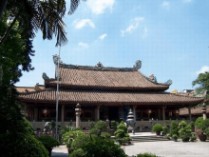
潮州开元寺
Kaiyuan Temple
[简介]
开元寺位于潮州市区开元路。据记载:开元寺的前身是创建于隋唐之际的荔峰寺。唐朝开元二十六年(738年),唐玄宗为庆祝自己的生日,下令全国81州郡各选一大寺,以其年号
为名,潮州就把“荔峰寺”改名为“开元寺”。现在开元寺的占地面积约为1、7万平方米,是一座宫殿式四合院建筑。开元寺是广东四大名寺之一,是粤东地区规模最大的古刹,2001年7月被国务院定位全国重点文物保护单位。开元寺的主要建筑分布在寺院的中轴线上,由南北依次为金刚殿、天王殿、大雄宝殿、藏经殿。在中轴线的东西两侧分别是地藏阁和观音阁。
[Introduction]
Kaiyuan Temple is located on Kaiyuan Road ,Chaozhou city .It is recorded that Kaiyuan Temple are formerly called Lifeng Temple ,constructed during Sui and Tang dynasties .In the 26 year of Kaiyuan , Tang dynasty (738 A. D.) ,to celebrate his birthday ,emperor Xuanzong ordered that each of the 81states and counties in the country should choose a big temple to be named after his reign title ,Kaiyuan ,so Lifeng Temple in Chaozhou was renamed Kaiyuan Temple.
Kaiyuan temple is a quadrangle in palace style, currently covering an area of 17,000 square meters .as one of the four most famous temples in Guangzhou province and the largest of its kind in east Guangdong reign, Kaiyuan temple was listed as the sky cultural relic protection units by the state council in July, 2001.The main
construction of Kaiyuan temple is laid out along the axis line. There are from south to north the Jingang(Saroyan) hall ,hall of heavenly king, Daxiong Bao Dian (mahavira hall) and scripture house .To the east and west of the axis line lie the pavilion of guardian deity of children (ksitigarbha) and kwan-yin pavilion respectively . th

[金刚殿]
金刚殿建于明朝,殿内供奉着两大金刚,他们是寺院的守护神,民间称之为“哼哈二将”。其中一位叫做密迹金刚。传说,释迦牟尼佛外出传法时,常有五百金刚随行护卫,密令金刚就是这五百金刚卫队的队长,密令金刚对面的是那罗延天,传说他是古印度的大力神。开元寺的金刚都是闭口端坐,手拿金刚圈。
[Jingang Hall]
Jingang Hall was built in Ming dynasty .There are tow Jingangs in the hall and they are it’s guardian spirits .They called as “Heng” and “Ha” generals by the folk. One of them is Miji (traceless) Jingang .According to legend, Sakyamuni used to have an armed escort of 500 Jingangs when he went out to preach, and Miji Jingang served as the captain of the guard .Opposite of Miji Jingang is Naroyan, he is said to be the most powerful spirit in ancient India .The jingang statues in Kaiyuan temple are all sitting up with months shut and Jing gang rings in hands.

[天王殿]
天王殿建于宋朝,是我国仅存的宋代单檐歇山顶建筑,在建筑上具有极高的价值。天王殿在建筑上有三个特点:第一,整座建筑有32根柱子,这些柱子都是木石结合,下端为石柱,上端为木柱,前排柱子与后排柱子式样有所不同。第二,天王殿东西两侧的山墙没有用石柱而是用砖砌,整个屋顶的重量由两侧山墙承载,这和我国传统的用柱来承载屋顶的重量的做法有所不同。第三,在柱子上端为层叠的斗拱连接屋顶,从下往上望,这些斗拱好像盛开的莲花,在民间把这些斗拱叫做“莲花托”。在天王殿内正上方一块牌匾上面写着“开元镇国禅寺”六个子,“镇国”两字不是一般寺庙可用的。开元寺之所以可以用“镇国”两字,是因为得到了朝廷的批准。在天王殿正中间供奉是的是弥勒佛。据佛经说,弥勒佛是未来世的佛祖,是现在世佛租释迦牟尼在未来世的接班人。开元寺天王殿供奉的是弥勒佛的化身像,即“大肚弥勒佛”。
[Hall of Heavenly King]
Built in Song Dynasty, the Hall of Heavenly King in the only existing Xieshan -styled-roof structure left over from the Song Dynasty and so is highly valued in architecture. This hall has three characteristics: Firstly, there are 32 pillars, all wood-stone combined, with wood of the upper part and stone of the lower end. The pillars in the front are somewhat different from those in the back. Secondly, there is no pillars at all in both the east and west gables, only brick walls to
support the housetop. This is different from the traditional way of using pillars to bear the weight. Thirdly, there is a cascade of arches on the upper pillars to join the roof. Looked from below, the arches seem blooming lotus flowers; hence they’ve got the name of “Lotus Torus” among the folk.
Inside the Hall of Heavenly King, there’s a tablet plaque in the upper middle with characters: “Kaiyuan Country Pacifying Buddhist Temple”. And the two characters” Country Pacifying” cannot be freely used if without the permission by the
court.Maitreya Buddha is in the middle of the Hall. He is said by Buddhist sutra to be the aftertime Buddha, the successor of now time Buddha Sakyamuni. The statue here is his incarnation characterized by his big belly, i.e. the “Big Belly Maitreya”.On the east and west sides are the four Heavenly Kings. The sculptures here differs from those in other temples: they all sit square, without one leg lift up as they generally do in other temples, because this is a “Country Pacifying Buddhist Temple”.
Behind Maitreya Buddha is Weiyou Bodhisattva facing Daxiong Bao Dian (Mahavira Hall). It is said that each of the four Heavenly Kings has eight generals; Weituo is the most important one for his protection of Buddhism among the thirty-two and receives the decrees from the Buddha directly.
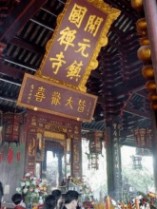
[中庭]
在天王殿北面是开元寺的中庭,即大雄宝殿前的广场。中庭的南边有两株菩提树,菩提在印度语的意思是“智慧”,因此菩提树也叫“智慧树”。传说,释迦牟尼是在菩提树下打坐,苦思冥想了7日7夜,终于大彻大悟成佛的。
在中庭的东西两侧有4座方形的石塔,这种形式的塔叫做“阿育王式塔”。在中庭北端大雄宝殿前有两座石经幢。据考证,这两座经幢是唐朝建寺时的原物,也是潮洲现存最早的石雕作品。
[The Countyard]
To the north of the Hall of Heavenly King is a courtyard, this is, the open area in front of Daxiong Bao Dian (Mahavia Hall). On the south of the courtyard are two bo-dhi trees. Bo-dhi tree is also called tree of wisdom, since bo-dhi means wisdom in Sanskirt. Legend has it was just under the bo-dhi tree that Sakyamuni attained
his great awakening after practicing meditation for 7 days and nights, and became Buddha.On the west and east sides are 4 quadrate stone pagodas in Asoka style. On the north side of the courtyard are 2 stone sutra pillars. They have been proved to be the original in Tang Dynasty when the temple was founded and also the oldest stone sculpture in Chaozhou.

[大雄宝殿]
在中庭北面是开元寺的核心建筑大雄宝殿。现在的大雄宝殿为清光绪年间重修的建筑。在大雄宝殿正中供奉的是佛教的教主释迦牟尼佛,我们中国人一般都把他叫做“如来佛”,释迦牟尼是佛教的创始人。在释迦牟佛东边的是药师佛,据说,众生只要诚心诵念他的佛号就能够消灾去病!在释迦佛西边的阿弥陀佛,他是西方极乐世界的教主,在中国佛教徒大多数都希望来世能够降生在西方极乐世界。在大雄宝殿东西两侧供奉的是十八罗汉。佛经上经,这些人已永远不再生死轮回,并留在人间替佛祖弘扬佛法。
[Sakyamuni Hall]
To the north of the courtyard lies the kernel structure-Daxiong Bao Dian (Sakyamuni Hall). It was rebuilt in Guangxu reign period, Qing Dynasty.
In the middle of the Daxiong Bao Dian is the statue of Sakyamuni, founder of Buddhism. We Chinese also call him Rulai Buddha.On the east side of Sakyamuni is apothecary Buddha. It is said that people can eliminate their personal misfortune and illness if they piously recite his Buddhist name over and over again. On the west side is Amitabha, the hierarch of the Pure Land in the west. Most Buddhists in China hope to have their afterlife in the Pure Land.On the west and east sides of the Daxiong Bao Dian are the 18 arhats. According to sutra, they will never have their afterlife and remain in the earthly world to preach for the Buddha.
[藏经楼]
在大雄宝殿北面是开元寺的藏经楼,这里珍藏着开元寺1000多年来收藏的众多珍贵的文物。其中有开元寺的镇寺之宝—清朝乾隆皇帝钦赐给潮洲开元寺的雍正版《大藏经》。这部《大藏经》刻于清朝雍正十三年(1753年),当时共刻印了10部,先后颁赐给全国十大寺院收藏,全书共7246卷,用汉、满、藏、蒙四种文字刊行。开元寺能够成为其中的一个收藏寺院,可见开元寺在中国各佛寺中的地位。
[Scripture House]
To the north of Daxiong Bao Dian is the Scripture House, keeping a lot of cultural relics of the temple collected for more that 1000 years. Among then the most precious is Dazangjing (Tripitaka) specially given to Kaiyuan Temple by Qianlong emperor? It is an edition of the 13 year of Yongzheng reign period, Qing Dynasty (1753A.
D.). There are total 7246 volumes for each of the 10 sets of Dazangjing (Tripitaka) printed in four languages: Chinese, Manchu, Tibetan and Mongolian and granted to 10 big temples nationwide. The importance of Kaiyuan Temple in China’s Buddhist temples is obvious for the fact that it is one of the temples to have the storage of Dazangjing (Tripitaka).
th

[地藏阁]
地藏阁中供奉的是地藏菩提和十大阎王。正面端坐的就是地藏菩提,传说他曾经为救其母脱离地狱之苦发下誓愿:“众生度尽,方证菩提,地狱未空,誓不成佛。”在地藏阁左右两侧分别是十大阎罗是地狱的统治者。
[Pavilion of the God Earth]
Here enshrined in this hall are the God of Earth and the ten Yamas who are said to be the rulers of the Hell. The one sitting in the middle is the God of Earth .Legend has it that, in order to rescue his mother from the Hell, he had made a vow that he would not become a Buddha until all people are saved from the Hell. On both sides are the 10 Yamas.
[观音阁]
观音阁内供奉的是观世音菩萨。由于观世音能救苦救难,在这个充满苦难的人世间,得到众生的爱戴,有众多的信众。我们现看到的观音像是一位慈祥端庄的妇女,在中国的观世音大多都是这种形象。在观音阁内左右两侧供奉的是18尊观世音的化身像。现在,在观音隔内供奉观音18化身像的在全国可能就只有开元寺一家了!这也是开元寺又一个与众不同之处。
[Kwan-yin Pavilion]
Here is the stature of Kwan-yin, the Goddess of Mercy. In this miserable earthly world, Kwan-yin is widely respected and has a large number of believers. From the stature here we can see Kwan-yin is a woman, kind and se-date, just like the image in other places of China.On both sides of the pavilion are 18 different statures of Kwan-yin. That in a Kwan-yin Pavilion her 18 different statues are on shrine is, perhaps, no-where but Kaiyuan. This is another why Kaiyuan Temple is different from others.
《导游实训教材》(Timwu 等编)

三 : 潮州开元寺
潮州开元寺——岭南名胜中英文导游(12)
转载
岭南名胜
中英文导游
旅游 ▼ (2011-01-22 13:46:28) 分类:新聊斋/朝花夕拾/旅游餐饮 标签:开元寺
岭南名胜中英文导游(12)
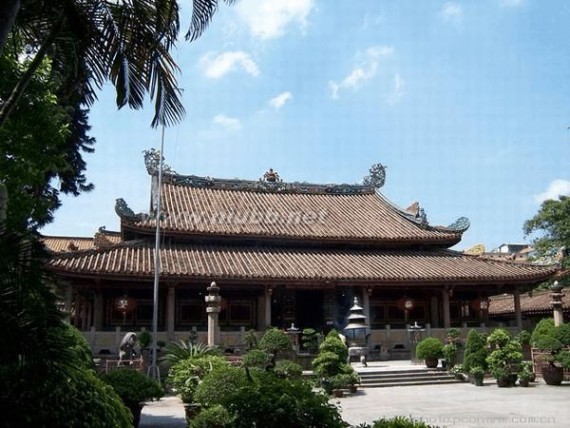
潮州开元寺
Kaiyuan Temple
[简介]
开元寺位于潮州市区开元路。[www.61k.com)据记载:开元寺的前身是创建于隋唐之际的荔峰寺。唐朝开元二十六年(738年),唐玄宗为庆祝自己的生日,下令全国81州郡各选一大寺,以其年号
潮州开元寺 潮州开元寺
为名,潮州就把“荔峰寺”改名为“开元寺”。[www.61k.com)现在开元寺的占地面积约为1、7万平方米,是一座宫殿式四合院建筑。开元寺是广东四大名寺之一,是粤东地区规模最大的古刹,2001年7月被国务院定位全国重点文物保护单位。开元寺的主要建筑分布在寺院的中轴线上,由南北依次为金刚殿、天王殿、大雄宝殿、藏经殿。在中轴线的东西两侧分别是地藏阁和观音阁。
[Introduction]
Kaiyuan Temple is located on Kaiyuan Road ,Chaozhou city .It is recorded that Kaiyuan Temple are formerly called Lifeng Temple ,constructed during Sui and Tang dynasties .In the 26 year of Kaiyuan , Tang dynasty (738 A. D.) ,to celebrate his birthday ,emperor Xuanzong ordered that each of the 81states and counties in the country should choose a big temple to be named after his reign title ,Kaiyuan ,so Lifeng Temple in Chaozhou was renamed Kaiyuan Temple.
Kaiyuan temple is a quadrangle in palace style, currently covering an area of 17,000 square meters .as one of the four most famous temples in Guangzhou province and the largest of its kind in east Guangdong reign, Kaiyuan temple was listed as the sky cultural relic protection units by the state council in July, 2001.The main
construction of Kaiyuan temple is laid out along the axis line. There are from south to north the Jingang(Saroyan) hall ,hall of heavenly king, Daxiong Bao Dian (mahavira hall) and scripture house .To the east and west of the axis line lie the pavilion of guardian deity of children (ksitigarbha) and kwan-yin pavilion respectively . th
潮州开元寺 潮州开元寺

[金刚殿]
金刚殿建于明朝,殿内供奉着两大金刚,他们是寺院的守护神,民间称之为“哼哈二将”。[www.61k.com)其中一位叫做密迹金刚。传说,释迦牟尼佛外出传法时,常有五百金刚随行护卫,密令金刚就是这五百金刚卫队的队长,密令金刚对面的是那罗延天,传说他是古印度的大力神。开元寺的金刚都是闭口端坐,手拿金刚圈。
[Jingang Hall]
Jingang Hall was built in Ming dynasty .There are tow Jingangs in the hall and they are it’s guardian spirits .They called as “Heng” and “Ha” generals by the folk. One of them is Miji (traceless) Jingang .According to legend, Sakyamuni used to have an armed escort of 500 Jingangs when he went out to preach, and Miji Jingang served as the captain of the guard .Opposite of Miji Jingang is Naroyan, he is said to be the most powerful spirit in ancient India .The jingang statues in Kaiyuan temple are all sitting up with months shut and Jing gang rings in hands.
潮州开元寺 潮州开元寺

[天王殿]
天王殿建于宋朝,是我国仅存的宋代单檐歇山顶建筑,在建筑上具有极高的价值。(www.61k.com]天王殿在建筑上有三个特点:第一,整座建筑有32根柱子,这些柱子都是木石结合,下端为石柱,上端为木柱,前排柱子与后排柱子式样有所不同。第二,天王殿东西两侧的山墙没有用石柱而是用砖砌,整个屋顶的重量由两侧山墙承载,这和我国传统的用柱来承载屋顶的重量的做法有所不同。第三,在柱子上端为层叠的斗拱连接屋顶,从下往上望,这些斗拱好像盛开的莲花,在民间把这些斗拱叫做“莲花托”。在天王殿内正上方一块牌匾上面写着“开元镇国禅寺”六个子,“镇国”两字不是一般寺庙可用的。开元寺之所以可以用“镇国”两字,是因为得到了朝廷的批准。在天王殿正中间供奉是的是弥勒佛。据佛经说,弥勒佛是未来世的佛祖,是现在世佛租释迦牟尼在未来世的接班人。开元寺天王殿供奉的是弥勒佛的化身像,即“大肚弥勒佛”。
[Hall of Heavenly King]
Built in Song Dynasty, the Hall of Heavenly King in the only existing Xieshan -styled-roof structure left over from the Song Dynasty and so is highly valued in architecture. This hall has three characteristics: Firstly, there are 32 pillars, all wood-stone combined, with wood of the upper part and stone of the lower end. The pillars in the front are somewhat different from those in the back. Secondly, there is no pillars at all in both the east and west gables, only brick walls to
潮州开元寺 潮州开元寺
support the housetop. This is different from the traditional way of using pillars to bear the weight. Thirdly, there is a cascade of arches on the upper pillars to join the roof. Looked from below, the arches seem blooming lotus flowers; hence they’ve got the name of “Lotus Torus” among the folk.
Inside the Hall of Heavenly King, there’s a tablet plaque in the upper middle with characters: “Kaiyuan Country Pacifying Buddhist Temple”. And the two characters” Country Pacifying” cannot be freely used if without the permission by the
court.Maitreya Buddha is in the middle of the Hall. He is said by Buddhist sutra to be the aftertime Buddha, the successor of now time Buddha Sakyamuni. The statue here is his incarnation characterized by his big belly, i.e. the “Big Belly Maitreya”.On the east and west sides are the four Heavenly Kings. The sculptures here differs from those in other temples: they all sit square, without one leg lift up as they generally do in other temples, because this is a “Country Pacifying Buddhist Temple”.
Behind Maitreya Buddha is Weiyou Bodhisattva facing Daxiong Bao Dian (Mahavira Hall). It is said that each of the four Heavenly Kings has eight generals; Weituo is the most important one for his protection of Buddhism among the thirty-two and receives the decrees from the Buddha directly.
潮州开元寺 潮州开元寺

[中庭]
在天王殿北面是开元寺的中庭,即大雄宝殿前的广场。[www.61k.com)中庭的南边有两株菩提树,菩提在印度语的意思是“智慧”,因此菩提树也叫“智慧树”。传说,释迦牟尼是在菩提树下打坐,苦思冥想了7日7夜,终于大彻大悟成佛的。
在中庭的东西两侧有4座方形的石塔,这种形式的塔叫做“阿育王式塔”。在中庭北端大雄宝殿前有两座石经幢。据考证,这两座经幢是唐朝建寺时的原物,也是潮洲现存最早的石雕作品。
[The Countyard]
To the north of the Hall of Heavenly King is a courtyard, this is, the open area in front of Daxiong Bao Dian (Mahavia Hall). On the south of the courtyard are two bo-dhi trees. Bo-dhi tree is also called tree of wisdom, since bo-dhi means wisdom in Sanskirt. Legend has it was just under the bo-dhi tree that Sakyamuni attained
潮州开元寺 潮州开元寺
his great awakening after practicing meditation for 7 days and nights, and became Buddha.On the west and east sides are 4 quadrate stone pagodas in Asoka style. On the north side of the courtyard are 2 stone sutra pillars. They have been proved to be the original in Tang Dynasty when the temple was founded and also the oldest stone sculpture in Chaozhou.

[大雄宝殿]
在中庭北面是开元寺的核心建筑大雄宝殿。(www.61k.com)现在的大雄宝殿为清光绪年间重修的建筑。在大雄宝殿正中供奉的是佛教的教主释迦牟尼佛,我们中国人一般都把他叫做“如来佛”,释迦牟尼是佛教的创始人。在释迦牟佛东边的是药师佛,据说,众生只要诚心诵念他的佛号就能够消灾去病!在释迦佛西边的阿弥陀佛,他是西方极乐世界的教主,在中国佛教徒大多数都希望来世能够降生在西方极乐世界。在大雄宝殿东西两侧供奉的是十八罗汉。佛经上经,这些人已永远不再生死轮回,并留在人间替佛祖弘扬佛法。
[Sakyamuni Hall]
潮州开元寺 潮州开元寺
To the north of the courtyard lies the kernel structure-Daxiong Bao Dian (Sakyamuni Hall). It was rebuilt in Guangxu reign period, Qing Dynasty.
In the middle of the Daxiong Bao Dian is the statue of Sakyamuni, founder of Buddhism. We Chinese also call him Rulai Buddha.On the east side of Sakyamuni is apothecary Buddha. It is said that people can eliminate their personal misfortune and illness if they piously recite his Buddhist name over and over again. On the west side is Amitabha, the hierarch of the Pure Land in the west. Most Buddhists in China hope to have their afterlife in the Pure Land.On the west and east sides of the Daxiong Bao Dian are the 18 arhats. According to sutra, they will never have their afterlife and remain in the earthly world to preach for the Buddha.
[藏经楼]
在大雄宝殿北面是开元寺的藏经楼,这里珍藏着开元寺1000多年来收藏的众多珍贵的文物。(www.61k.com]其中有开元寺的镇寺之宝—清朝乾隆皇帝钦赐给潮洲开元寺的雍正版《大藏经》。这部《大藏经》刻于清朝雍正十三年(1753年),当时共刻印了10部,先后颁赐给全国十大寺院收藏,全书共7246卷,用汉、满、藏、蒙四种文字刊行。开元寺能够成为其中的一个收藏寺院,可见开元寺在中国各佛寺中的地位。
[Scripture House]
To the north of Daxiong Bao Dian is the Scripture House, keeping a lot of cultural relics of the temple collected for more that 1000 years. Among then the most precious is Dazangjing (Tripitaka) specially given to Kaiyuan Temple by Qianlong emperor? It is an edition of the 13 year of Yongzheng reign period, Qing Dynasty (1753A.
D.). There are total 7246 volumes for each of the 10 sets of Dazangjing (Tripitaka) printed in four languages: Chinese, Manchu, Tibetan and Mongolian and granted to 10 big temples nationwide. The importance of Kaiyuan Temple in China’s Buddhist temples is obvious for the fact that it is one of the temples to have the storage of Dazangjing (Tripitaka).
th
潮州开元寺 潮州开元寺
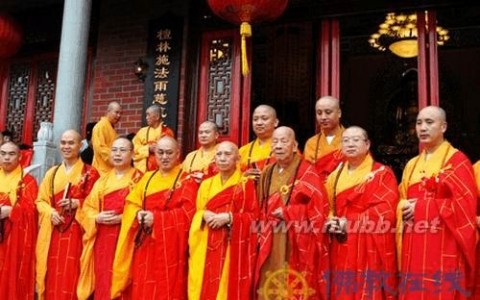
[地藏阁]
地藏阁中供奉的是地藏菩提和十大阎王。(www.61k.com)正面端坐的就是地藏菩提,传说他曾经为救其母脱离地狱之苦发下誓愿:“众生度尽,方证菩提,地狱未空,誓不成佛。”在地藏阁左右两侧分别是十大阎罗是地狱的统治者。
[Pavilion of the God Earth]
Here enshrined in this hall are the God of Earth and the ten Yamas who are said to be the rulers of the Hell. The one sitting in the middle is the God of Earth .Legend has it that, in order to rescue his mother from the Hell, he had made a vow that he would not become a Buddha until all people are saved from the Hell. On both sides are the 10 Yamas.
[观音阁]
观音阁内供奉的是观世音菩萨。由于观世音能救苦救难,在这个充满苦难的人世间,得到众生的爱戴,有众多的信众。我们现看到的观音像是一位慈祥端庄的妇女,在中国的观世音大多都是这种形象。在观音阁内左右两侧供奉的是18尊观世音的化身像。现在,在观音隔内供奉观音18化身像的在全国可能就只有开元寺一家了!这也是开元寺又一个与众不同之处。
潮州开元寺 潮州开元寺
[Kwan-yin Pavilion]
Here is the stature of Kwan-yin, the Goddess of Mercy. In this miserable earthly world, Kwan-yin is widely respected and has a large number of believers. From the stature here we can see Kwan-yin is a woman, kind and se-date, just like the image in other places of China.On both sides of the pavilion are 18 different statures of Kwan-yin. That in a Kwan-yin Pavilion her 18 different statues are on shrine is, perhaps, no-where but Kaiyuan. This is another why Kaiyuan Temple is different from others.
《导游实训教材》(Timwu 等编)

四 : 潮州开元寺好玩吗 粤东地区第一古刹
潮州开元寺好玩吗?开元寺怎么样?下面是有关开元寺的介绍及游客的点评,一起来了解一下吧。[www.61k.com]
开元寺简介:
开元寺位于广东省潮州市区中心。前身为荔峰寺,唐代开元二十六年(738年)敕建开元寺,元代改为“开元万寿禅寺”,明代称:“开元镇国禅寺”,又称”镇国开元禅寺”,加额“万寿宫”,俗称开元寺一直沿用至今。向为历朝祝福君主、宣讲官府律令之所。以地方宽敞、殿阁壮观、圣像庄严、文物众多、香火鼎盛而名闻遐迩,为粤东地区第一古刹,有“百万人家福地,三千世界丛林”之美誉。
开元寺好玩吗?来看看游客们是如何评价的吧。
1、开元寺,免费,现在进去的正门已不是原始的正门,翻新过的开元寺多了一份游览、宣传的味道,少了一份原始的庄严和沉淀。
2、从中心客运站乘40路就能到开元寺的,门票10元,60以上老人免费。重点境点有两个,一胩塔镇国塔,一个仁寿塔两石塔,俗称东西塔。院子很大,主殿也很气派,里面的建筑一直保持着古老的风貌,保存着最原始的唐风,里面的赑屃,须弥塔还有钟楼等等,并没有过度修复,也没有游人如织,在这里你可以静静地感受那来自千百年前的唐朝气息。,感受历史,欣赏古建筑,是个不错的地方。游览时间约1.5小时。
3、门票好像是10元,是一张纪念磁卡,地方挺大的,最漂亮的就是东西两座砖石佛塔,非常气派和精美。寺庙内还有弘一法师(李叔同)纪念馆,还有古船博物馆,也值得一看。寺庙算是非常富有的,有养老院和骨灰堂,寺庙的佛堂也是非常有特色的,尤其是塔状大殿结构,非常的精美壮观。
4、目标直奔开元寺,周围是景点集中区。推荐的游玩方式是:雇那些在路边揽客的三轮车夫。小雨天可防雨,坐得稳。还兼讲解。可以节省不少时间。
5、开元寺和牌坊街都是挨着的,离韩江也很近的,游过了牌坊街,来到了广东四大名寺的开元寺---开国禅师哦;还是很有历史的,而且地位在粤东就是第一佛教寺庙,门票很实惠,10块钱一个人;里面多是菩萨的像,还有三生佛,三世佛等等,对于佛教徒的我来说,这是一个难得的地方,作揖磕头是必须的,里面的建筑还不错。来这里好好看看,如果可以也可以给佛家捐些小钱。这里有一个很大的捐赠栏,李嘉诚的捐款最多,100万港币
6、开元寺也是古寺了,从唐朝就开始建立起来。走进去让人感到很宁静舒服。丝毫不会有那种不舒服的感觉。里头的建筑也是很有特色的。柱子上雕刻着栩栩如生的龙腾。房梁上也有雕刻着龙头。屋檐的翘脚也非常有特色。有信仰的人可以诚心拜佛,无信仰的人也可以进去欣赏一下古建筑的独有魅力。
7、开元寺里最喜欢那些古树了,其他的没有什么特别
8、门票价5元~~带着参观的心情我就没有买香品。进去之后觉得这个禅寺很正规,不是单纯的旅游景点,很多长老还有俗家弟子在诵经,氛围还是很神圣的,如果有什么愿望或者难题,诚心的去祈求一下应该能灵验。寺庙装饰非常华丽,屋顶上的琉璃、瓷器点缀的又精致又大气,很漂亮。周围的盆景加上隐隐飘来的香气,让人突然变得沉静凝重。
以上就是有关潮州开元寺的介绍及游客的点评,相信大家有所了解了,希望可以给你们作参考。
本文标题:潮州开元寺-潮州开元寺:潮州开元寺-简介,潮州开元寺-地理位置61阅读| 精彩专题| 最新文章| 热门文章| 苏ICP备13036349号-1